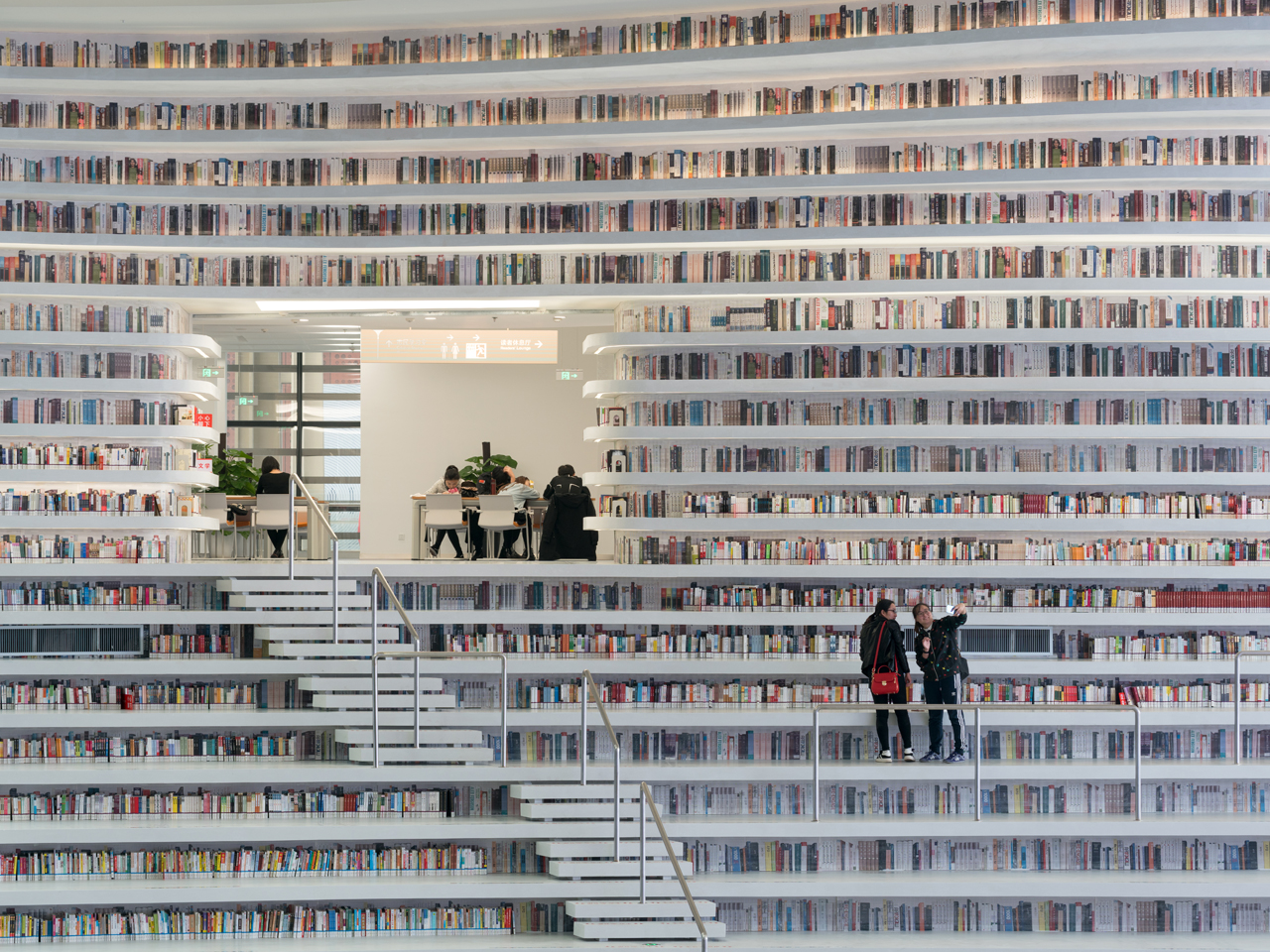Ocean of Books

Go on, judge a book by its cover. Why stop there? Judge it by the home it keeps. In the Tianjin Binhai Library, you might think none of the parts is disconnected. With curves like a brain and delicate fibers like the iris of an eye, it’s a building that seems to sculpt the reading experience and the mercurial quality of culture in physical space.
Designed by the Rotterdam-based architectural firm, MVRDV, in collaboration with the Tianjin Urban Planning and Design Institute, the library is part of an initiative to invigorate the cultural district of Binhai in Tianjin, China. It’s one of five cultural buildings by a team of international architects that make up the larger project, and in terms of international attention, it’s really the eye of the storm. “The Eye,” fittingly, is its nickname, given the eye-shaped opening that looks into the building from the outside park and the central sphere that sits on the lower lid like an iris. The Tianjin Binhai Municipality commissioned MVRDV, which has secondary offices in Shanghai and has worked in Tianjin previously, completing the commercial and residential TEDA Urban Fabric buildings in 2009. MVRDV has its roots in Rotterdam where, in 1993, Winy Maas, Jacob van Rijs and Nathalie de Vries founded the firm with the objective to “engage globally in providing solutions to contemporary architectural and urban issues.” With a groundbreaking eco-friendly office building called “The Pushed Slab” in Paris, a remote cultural center in the mountainous Japanese village of Matsudai, the iconic Mirador and Celosia housing complex in Madrid—over the last quarter century the three founders have studded the world with “exemplary, outspoken projects, which enable our cities and landscapes to develop towards a better future.”
The Tianjin Binhai Library is the firm’s most rapid and efficient project to date. Working with a pace almost unheard-of in American cities, it was a mere three years between the first sketch and the opening on October 1, 2017. That schedule isn’t the only thing superhuman about it; the futuristic library looks like a ship that just arrived from space, or else like a dream of the universe growing in the mind of the Argentine author Jorge Luis Borges, like “The Library of Babel”. It’s a cavernous 33,700m space that has a capacity for 1.2 million books, with undulating floor-to-ceiling shelves and a central auditorium located in the sphere at its heart. Taking a seat on any shelf, books are stashed behind your back and legs, beneath your feet, above you and all around—a veritable drowning. The library consists of five levels, with the atrium leading to numerous educational facilities behind the shelves and descending into subterranean service spaces, book storage and an archive. From the ground up, the lower floors consist of reading rooms and lounges, and as you ascend they transform into meeting and tech/audio spaces, finally peaking with the magic words we all love to hear: two rooftop patios.

There’s just one snag: due to the extremely tight schedule, construction of the curvy library cut a corner that has caused some marginal criticism in the media since the project’s premiere. The problem? Access to the upper shelves of the atrium is currently impossible. The shelves were intended to provide access to the uppermost rooms. You can imagine it: books facing out to the atrium, illuminated by the high skylight and looking down on the massive “Eye,” while also facing inward to the cells of the honeycomb. The concept is beautiful. However, in the whirlwind to meet deadlines, a change that made these shelves inaccessible “was made locally and against MVRDV’s advice.” Perforated aluminium plates represent books on these high shelves. While it is a disappointment, it should by no means stem the tide of enthusiasm owing to what CCTV has called the “Ocean of Books.” We can still hope that the original concept sees light in the future.
The library has become a darling of Chinese media and social media. It’s a triumph of knowledge, urban engineering and cultural enlivenment, and in April 2018 the “most beautiful library of China” (The Bund) won the International Architecture category for Land Rover’s BORN Awards. Pretty cool. But it’s not just about the accolades, is it? Libraries connect people with each other and with the past, and they occupy our world with more give-and-take than most other buildings. In the words of Winy Maas, co-founder of MVRDV, “to see and be seen” is part of the purpose—to be taken in by the “‘eye’ of the building.” Every sign indicates that the people of Tianjin would agree; they are bringing life into the new space, embracing it as it should be, “a new urban living room.”
Text Cameron Jones
Images Courtesy of The Tianjin Binhai Library

